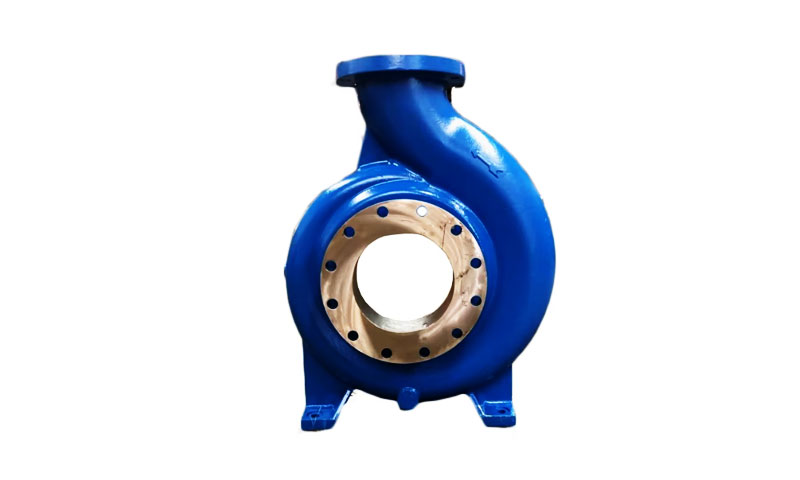1. مقدمه
Pump bodies are structural and hydraulic housings that convert driver energy into fluid motion. They commonly contain volutes, impeller seats, bearing bosses, flanges and internal passages.
The manufacturing route chosen for a pump body sets achievable geometry, متالورژی, cost and lead time.
Investment casting stands out where geometry is complex (internal guide vanes, thin webs, integrated bosses), tolerances are tight, and high-integrity alloys (فولادهای ضد زنگ, آلیاژهای نیکل, برنز) لازم هستند.
2. What Is an Investment Casting Pump Body?
Definition and core functionality
در سرمایه گذاری سرمایه گذاری pump body is a pump housing produced by the lost-wax (سرمایه گذاری) روش ریخته گری.
A wax (یا پلیمر) pattern of the pump body is created, coated in refractory ceramic to build a shell, the wax removed by heating, and molten metal poured into the ceramic mold.
The fired shell is broken away after solidification to reveal a near-net cast pump body that is subsequently finished and inspected.
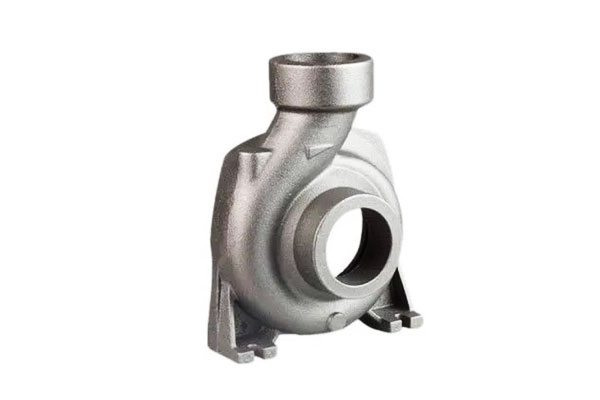
Typical specifications and dimensions
- Part mass: investment cast pump bodies usually range from a few hundred grams to tens of kilograms per piece; many foundries routinely cast pump bodies from ~0.5 kg up to ~50–100 kg depending on plant capability.
- ضخامت دیواری: typical nominal walls for stainless or nickel alloys: 3-12 میلی متر; minimum thin sections down to 1- 2 میلی متر are achievable in selected alloys and process control.
- تحمل ابعادی (دارای بازار بی نظیر): general investment cast tolerances commonly fall in 0.1-0.5 میلی متر for small features; percent-based tolerance of ±0.25–0.5% linear is a practical rule of thumb.
Critical machined features are usually left with machining allowance (0.2–2.0 mm depending on casting accuracy). - پایان سطح (دارای بازار بی نظیر): typical Ra 1.6-3.2 میکرومتر (50–125 دقیقه) for standard ceramic shells; fine shells and careful pouring can produce Ra ≈ 0.8–1.6 μm.
Sealing faces or bearing journals are machined/lapped to much finer Ra (رده 0.2 μM) as required.
3. ملاحظات طراحی
Investment casting enables complex geometry, but good design practice maximizes quality and minimizes cost.
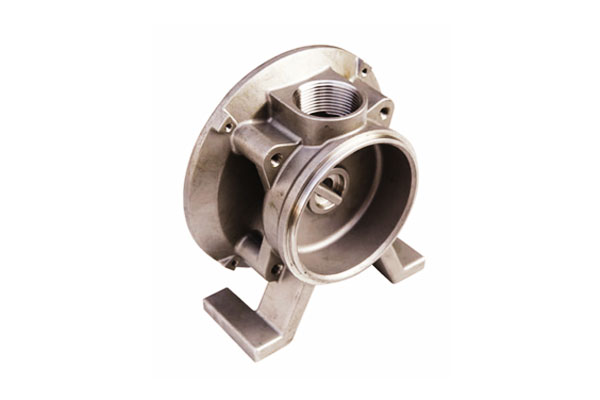
Hydraulic performance requirements
- Flow passages & volutes: smooth fillets and controlled convergence avoid separation and cavitation.
Internal fillet radii should be generous (≥ 1–2× wall thickness) to reduce turbulence. - Impeller seat alignment: concentricity and perpendicularity are critical — plan for machined bores and datum features.
- Clearances: pump clearances at impeller overhangs and seal faces must be maintainable by post-cast machining.
Structural requirements
- Stress & خستگی: consider cyclical loads; use finite-element analysis to identify local stress risers.
Cast metallurgy (اندازه دانه, تفکیک) affects fatigue life—design to avoid thin, highly stressed bosses without proper filleting. - Vibration: stiff webs and ribs help raise natural frequencies; investment casting allows ribs to be integrated into the body.
خوردگی & پوشیدن
- انتخاب مواد: choose alloy based on fluid chemistry (PH, کلرید, ذرات فرساکی, درجه حرارت).
For seawater, duplex or cupronickel may be required; for acids, Hastelloy or appropriate nickel alloys. - Erosion resistance: smooth internal surfaces and sacrificial coatings (حیا, اسپری حرارتی) are options where particulate slurry is present.
تحمل های بعدی & پایان سطح
- ویژگی های بحرانی: designate which faces/bores are finish-machined and specify machining allowances (به عنوان مثال, 0.5–1.5 mm for sandier shells, 0.2–0.6 mm for precision shells).
- Sealing surfaces: specify Ra and flatness; often lapped/polished to Ra ≤ 0.2 μm and flatness within 0.01-0.05 میلی متر depending on pressure class.
4. Materials for Investment Casting Pump Bodies
Material selection is a critical factor in designing and producing investment-cast pump bodies, as it directly affects mechanical performance, مقاومت در برابر خوردگی, تولید, و زندگی خدمت.
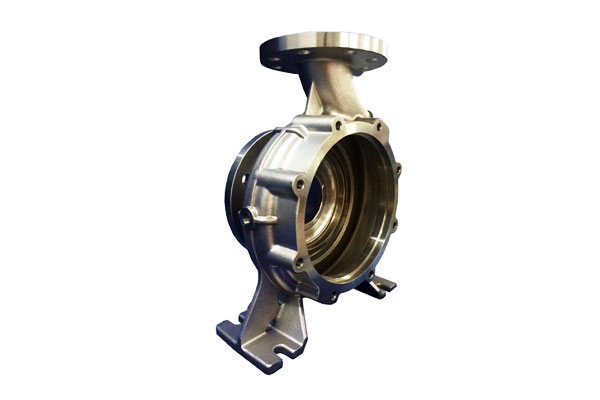
| دسته مواد | به عنوان مثال آلیاژها | خصوصیات کلیدی | برنامه های معمولی | ملاحظات ریخته گری |
| وابسته به اوستن فولاد ضد زنگ | 304, 316سعادت | مقاومت در برابر خوردگی عالی, استحکام متوسط, جوشکاری خوب; کشنده: 480-620 MPa, بازده: 170-300 MPa, کشیدگی: 40-60 ٪ | General chemical pumps, تصفیه آب, غذا & نوشیدنی | Good molten fluidity, low hot-cracking risk, easy post-machining |
| فولاد ضد زنگ دوبلکس | 2205, 2507 | استحکام بالا (Yield 450–550 MPa), superior chloride stress corrosion resistance | Marine and offshore pumps, محیط های شیمیایی تهاجمی | Requires controlled temperature; post-casting heat treatment to prevent sigma phase |
آلیاژهای نیکل |
ناله 625, 718; هستلووی | مقاومت در برابر خوردگی استثنایی, قدرت درجه حرارت بالا, مقاومت در برابر اکسیداسیون | پردازش شیمیایی, نیروگاه, روغن & گاز | High melting points (≈1450–1600 °C); careful mold preheating and controlled pouring needed; difficult machining |
| برنز and Copper Alloys | C93200, C95400 | مقاومت در برابر خوردگی آب دریا عالی, مقاومت در برابر سایش خوب, antifouling; lower mechanical strength | پمپ های دریایی, خنک کننده آب دریا, اجزای هیدرولیکی | Lower melting points (≈1050–1150 °C) simplify casting; low thermal cracking risk; mechanical strength lower than stainless/nickel |
5. Investment Casting Process for Pump Bodies
سرمایه گذاری سرمایه گذاری, همچنین به عنوان شناخته می شود ریخته گری موم گمشده, enables the production of pump bodies with complex geometries, دیوارهای نازک, و دقت ابعادی بالا.
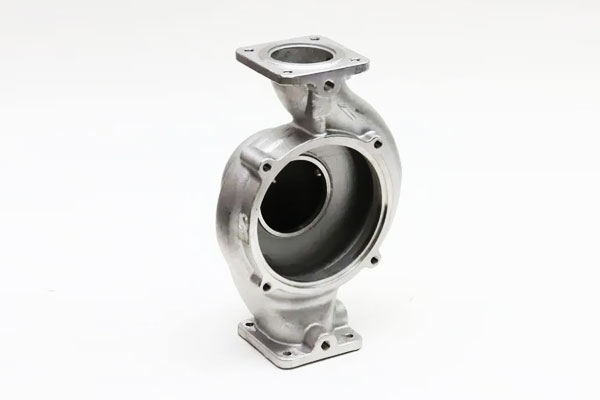
The process consists of several critical steps:
| پله | توضیحات | ملاحظات کلیدی |
| 1. ایجاد الگوی موم | Molten wax is injected into precision molds to form replicas of the pump body. | Ensure uniform wall thickness; maintain dimensional accuracy ±0.1 mm; use high-quality wax to prevent distortion. |
| 2. Assembly of Wax Tree | Individual wax patterns are attached to a central wax sprue to form a tree for batch casting. | Sprue design affects metal flow; minimize turbulence during pouring. |
| 3. ساختمان پوسته سرافیکی | Repeated dipping in ceramic slurry and stuccoing with fine refractory sand creates a strong, پوسته مقاوم در برابر گرما. | Target shell thickness (5-10 میلی متر) depends on pump body size; avoid cracks and porosity in the shell. |
| 4. Dewaxing and Mold Firing | Wax is melted out (autoclave or kiln), ترک یک حفره; the ceramic shell is then fired to remove residues and strengthen the mold. | Temperature ramping must be controlled to prevent shell cracking; residual wax must be fully removed. |
5. ریزش فلزی |
فلز مذاب (فولاد ضد زنگ, nickel alloy, یا برنز) is poured into the preheated ceramic mold under gravity or vacuum-assisted conditions. | Pouring temperature and rate must ensure complete filling; control turbulence and prevent oxide formation. |
| 6. جامد سازی و خنک کننده | Metal solidifies inside the mold; cooling rates affect microstructure, خصوصیات مکانیکی, و استرس باقیمانده. | Thick sections may require controlled cooling to prevent porosity; thin walls must avoid hot tearing. |
| 7. حذف پوسته | Ceramic shell is broken away mechanically, often using vibration, sand blasting, or chemical dissolution. | Avoid damaging intricate pump channels or flanges. |
| 8. Finishing and Cleaning | Residual ceramic, gating system, and surface imperfections are removed via grinding, انفجار شات, or chemical cleaning. | Maintain dimensional tolerances; prepare surfaces for subsequent machining or coating. |
6. عملیات پس از ریخته گری
After the pump body is removed from the ceramic shell, several post-casting operations are performed to ensure the component meets functional, ابعادی, و الزامات کیفیت سطح.
These operations are critical for high-performance applications in chemical, دریایی, و بخش های صنعتی.
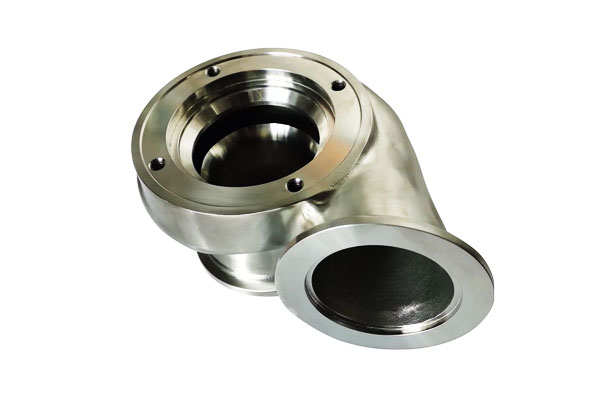
عملیات حرارتی
عملیات حرارتی is applied to relieve residual stresses, انعطاف پذیری را بهبود بخشید, and optimize mechanical properties:
- بازپرداخت تسکین استرس: Heating to 550–650 °C for stainless steels reduces residual stress from casting and prevents distortion during machining.
- بازپخت راه حل: Applied for stainless steels and nickel alloys to homogenize microstructure and dissolve unwanted precipitates, ensuring corrosion resistance and consistent hardness.
- Aging or Precipitation Hardening (for certain alloys): Enhances strength and wear resistance in high-performance materials.
ماشینکاری
Critical dimensions such as flanges, سوراخ, mating surfaces, and threaded ports are machined to meet tight tolerances.
Typical machining operations include turning, آسیاب کردن, حفاری, and boring. Machining ensures:
- Dimensional tolerances of ±0.05–0.1 mm for precise assembly.
- Smooth sealing surfaces to prevent leaks in high-pressure applications.
تکمیل سطح
پایان سطحی مقاومت در برابر خوردگی را تقویت می کند, مقاومت در برابر پوشیدن, و زیبایی شناسی:
- جلا دادن: Improves smoothness for sealing faces and internal channels.
- انفجار شات: Removes residual ceramic particles and creates a uniform surface for coating or painting.
- پوشش: Optional chemical or electroplated coatings (به عنوان مثال, نیکل, PTFE) enhance corrosion resistance and reduce friction.
آزمایش غیر مخرب (NDT)
To detect defects such as porosity, ترک, or inclusions, NDT is performed:
- رادیوگرافی (اشعه ایکس): Identifies internal voids and inclusions.
- تست اولتراسونیک (در): Detects subsurface flaws in thick sections.
- آزمایش نفوذ رنگ (PT): Reveals surface cracks and porosity.
Cleaning and Inspection
بالاخره, pump bodies are cleaned to remove residual machining oils, بقایای, or salts. Dimensional and visual inspections verify compliance with specifications before assembly or shipment.
7. Quality Assurance and Testing
تضمین کیفیت (QA) is critical in ensuring that investment casting pump bodies meet design specifications, performance standards, و الزامات صنعت.
A systematic QA approach combines dimensional checks, تست مکانیکی, and non-destructive evaluation to detect defects and confirm functional integrity.
بازرسی بعدی
Dimensional verification ensures that the pump body conforms to design drawings and tolerances:
- دستگاه های اندازه گیری مختصات (CMM): Measure complex geometries, سوراخ, فلنج, and mounting surfaces with accuracy of ±0.01–0.05 mm.
- Gauge Tools: Thread gauges, plug gauges, and height gauges verify critical features quickly in production.
- اندازه گیری زبری سطح: Confirms finishing requirements for sealing faces and internal channels (به عنوان مثال, Ra ≤0.8 μm for hydraulic components).
Mechanical Property Verification
Mechanical testing validates that the material meets required strength, انعطاف پذیری, و سختی:
- تست کششی: Measures yield strength, ultimate tensile strength, و کشیدگی, ensuring the material can withstand operational loads.
- تست سختی: Rockwell or Vickers testing confirms that heat treatment and material processing achieved the desired hardness.
- تست ضربه (در صورت لزوم): Evaluates toughness for applications exposed to fluctuating loads or shock.
آزمایش غیر مخرب (NDT)
NDT techniques detect hidden defects without damaging the part:
- رادیوگرافی (X-ray/CT Scanning): Identifies internal porosity, اجزاء, and voids, particularly in thick sections.
- تست اولتراسونیک (در): Detects internal cracks, حواس, or delaminations in dense materials like stainless steel and nickel alloys.
- آزمایش نفوذ رنگ (PT): Reveals surface cracks, سوراخ, or fine porosity not visible to the naked eye.
- آزمایش ذرات مغناطیسی (مگس): Applied for ferromagnetic alloys to detect surface and near-surface discontinuities.
Common Casting Defects and Mitigation Strategies
- تخلخل: Minimized through proper gating, دریچه, and controlled solidification rates.
- حفره های کوچک شدن: Addressed via riser design and thermal management.
- خاموش و اشتباهات سرد: Avoided by maintaining optimal pouring temperatures and smooth flow in complex geometries.
- Surface Inclusions: Controlled by using high-purity alloys and proper degassing techniques.
8. Advantages of Investment Casting for Pump Bodies
- هندسه پیچیده: معابر داخلی, thin walls and integrated bosses with minimal secondary assembly.
- شکل نزدیک شبکه: reduces material removal vs. rough machining from bar or billet — often 30–70% less machining برای قطعات پیچیده.
- دقت ابعادی بالا & پایان سطح: less secondary finishing for many features compared with sand casting.
- Alloy flexibility: cast many stainless and nickel alloys with good metallurgical integrity.
- Small to medium production flexibility: tooling for wax patterns is relatively inexpensive vs. large die tooling, enabling economic runs from prototypes to thousands of parts.
9. محدودیت ها و چالش ها
- Cost for very large parts: above certain sizes (بارها >100 کلوت) investment casting becomes uneconomical compared with sand casting or fabricating/ welding.
- زمان پیشرو: pattern tooling, shell building and firing add lead time—prototype timelines usually measured in weeks.
- Porosity risk in thick sections: thick bosses or large cross-sections require careful gating, chills or segmenting to avoid shrinkage.
- Surface finish and tolerances depend on shell system: achieving ultra-fine finishes or extremely tight as-cast tolerances requires premium ceramic systems and process control.
10. کاربردهای صنعتی
Investment casting pump bodies are used across a broad spectrum of industries due to their complex geometry capabilities, تطبیق پذیری مواد, و دقت ابعادی بالا.
The process allows engineers to design optimized hydraulic passages, دیوارهای نازک, and integrated mounting features that improve pump efficiency and longevity.
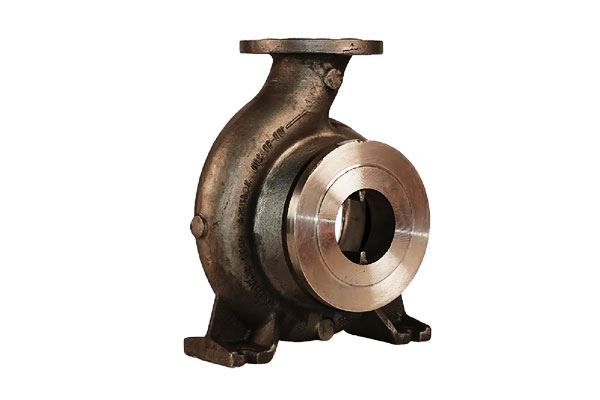
Chemical Processing Pumps
- محیط: Corrosive fluids such as acids, caustics, و حلالها.
- Materials Used: فولادهای ضد زنگ (316سعادت, دوتایی) and nickel alloys (هستلووی, ناله).
- عقاید: Investment casting enables intricate internal channels, minimizing turbulence and ensuring uniform flow, critical for chemical process reliability.
Water and Wastewater Pumps
- محیط: High-volume pumping, abrasive suspended solids, and variable pH levels.
- Materials Used: برنز, فولاد ضد زنگ دوبلکس, and corrosion-resistant cast irons.
- عقاید: Thin-wall, smooth internal passages reduce clogging and energy losses, improving efficiency in municipal and industrial water systems.
Marine and Offshore Pumps
- محیط: Saltwater exposure, high-pressure operation, and cyclical mechanical stress.
- Materials Used: آلیاژهای مس (برنج دریایی, برنز), فولادهای ضد زنگ دوبلکس.
- عقاید: Resistance to corrosion and biofouling is critical; investment casting allows seamless, complex geometries to reduce maintenance and improve service life.
روغن & Gas and Power Generation Pumps
- محیط: درجه حرارت بالا, high-pressure fluids, and hydrocarbon-based media.
- Materials Used: High-nickel alloys (ناله, هستلووی), فولاد ضد زنگ, and cobalt-based alloys.
- عقاید: Investment casting supports high-strength materials and precise tolerances necessary for critical applications such as turbine lubrication, chemical injection, and offshore drilling.
Specialty and Custom Pumps
- محیط: Laboratory, دارویی, or food processing applications requiring hygienic and precision performance.
- Materials Used: فولاد ضد زنگ (304, 316سعادت), تیتانیوم, یا آلیاژهای نیکل.
- عقاید: سطوح صاف, تحمل های تنگ, and complex geometries achieved by investment casting ensure minimal contamination risk and compliance with regulatory standards.
11. تحلیل تطبیقی
| نشان / معیارها | ریخته گری سرمایه گذاری | ریخته گری | Machining from Solid |
| پیچیدگی هندسی | Excellent – thin walls, کانال های داخلی, intricate features achievable | Moderate – limited by core placement and mold stability | Limited – complex internal geometries often impossible without assembly |
| دقت | High – ±0.1–0.25 mm typical | Moderate – ±0.5–1.0 mm | Very High – ±0.05 mm achievable |
| پایان سطح (رگ) | Fine – 1.6–3.2 μm typical; can be polished | Rough – 6–12 μm; requires machining for precision | Excellent – 0.8–1.6 μm achievable with finishing |
| گزینه های مادی | Wide – stainless steels, آلیاژهای نیکل, برنز, آلیاژهای مس | Wide – iron, فولاد, برنز, الومینیوم | Wide – depends on machinable stock availability |
| اندازه دسته | Low-to-medium – 1–1000+ parts | Medium-to-high – economical for large, قطعات ساده | Low – material waste increases cost for large parts |
| زمان پیشرو | Moderate – wax pattern & shell building required | Short-to-moderate – mold preparation relatively quick | Variable – depends on machining complexity |
زباله های مادی |
Low – near-net shape reduces scrap | Moderate – gating and risers generate some waste | High – subtractive process creates chips and offcuts |
| هزینه در هر قسمت | Moderate-to-high – tooling and process steps increase cost, economical for complex parts | Low-to-moderate – simpler molds, larger parts cheaper | High – extensive machining on large, complex parts is expensive |
| قدرت & یکپارچگی | Excellent – dense microstructure, minimal porosity if controlled | Moderate – risk of sand-related inclusions and porosity | Excellent – homogeneous, بدون نقص ریخته گری |
| Post-Processing Required | Often minimal – some machining, اتمام | Usually significant – machining and finishing required | Minimal – final finishing for tight tolerances only |
| برنامه های معمولی | Pump bodies with thin walls, complex hydraulic channels, مقاومت در برابر خوردگی | بزرگ, simple pump housings or structural components | Custom or prototype pump bodies requiring extreme precision |
12. پایان
Investment casting pump body combines design freedom with metallurgical integrity, making them an excellent choice for many fluid-handling applications—especially where complex internal geometry, exotic alloys or tight tolerances are required.
Success depends on early design for casting, informed material selection, careful process control (ریختن, shelling, عملیات حرارتی), and robust QA/NDT programs.
For critical pump systems—marine, chemical or power generation—investment casting can deliver reliable, economical components when specified and executed correctly.
متداول
What maximum size of pump body can be investment cast?
Typical shop practice ranges up to ~50–100 kg per part, but the practical maximum depends on foundry capability and economics.
Very large pump bodies are more often produced by sand casting or fabricating/welding.
How much machining allowance should I design into an investment casting?
اجازه دادن 0.2-2.0 میلی متر depending on the criticality and shell precision. Specify tighter allowances only where the foundry guarantees precision shells.
Which material is best for seawater pump bodies?
Duplex stainless steels and selected copper-nickel alloys are common choices due to superior chloride pitting resistance and biofouling performance; final selection depends on temperature, velocity and erosion conditions.
What is the typical turnaround time for an investment-cast pump body?
Small production runs typically take 4-8 هفته from pattern approval to finished parts; single prototypes can be faster with 3D-printed patterns but still require shell firing and melt schedules.
How do I specify acceptance criteria for porosity?
Use industry NDT standards (رادیوگرافی, CT, در) and define acceptance levels in percent porosity by volume or via reference images.
Critical pressure-retaining pump bodies often require porosity <0.5% by volume and radiographic acceptance per customer standard.
